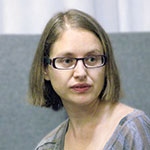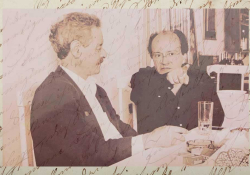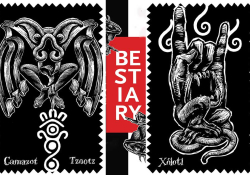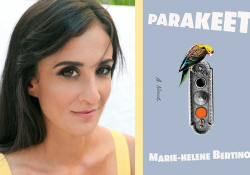Women in Public Art: An Essay

A few years ago, on a brief visit to Seville, Spain, my husband, son, and I came across an unexpected sculpture. Having cruised by the monuments to monarchs, priests, explorers, and bullfighters, we spotted a little bronze girl, sitting on a pile of books, a book in her hands, a few toys scattered on the pedestal next to her. This turned out to be a recent commission, commemorating Clara Campoamor, Spain’s famous suffragist who in 1931 won the women of the country the right to vote.
That sculpture transformed my experience with the city of Seville. If, until that visit, I thought of Seville as the hotbed of the Spanish Inquisition and persecution of the Jews, that sculpture helped me connect with its creator, Anna Jonsson, the feminist artist and a transplant to Seville from Sweden. I’ve been following her Instagram feed (@algo_anda_mal), where she posts photographs of her work on paper, in clay, her knitted and stitched creations, each of which is a powerful and whimsical statement against patriarchy. I long to return to her Seville studio and visit the showrooms where she displays her work.
San Francisco, where I live, is, on par with Seville, a popular tourist destination. As a writer, I often wonder what images of the city people carry away from their visits here. Perhaps it’s the fog curling over the Golden Gate Bridge. Perhaps it’s the souvenir shops at Fisherman’s Wharf. Likely, it’s the people sleeping in abject poverty on the city sidewalks. If asked what notable person comes to mind when you think of San Francisco, the name that a visitor rattles off might reflect their own walk of life, but be it that of a businessperson, a film director, an entertainer, a politician, a scientist, an environmentalist, or a computer engineer, more likely than not, it will be a male name.
Despite the fact that women in the United States attained the right to vote nearly one hundred years ago, we are far from attaining parity in most forms of public life. Women have won a record number of seats in the current United States Congress, but only 24 percent of the total. In San Francisco, politically one of the country’s most progressive cities, the situation is a little better. Currently four of the eleven members of our Board of Supervisors are women (36 percent). In 2018 we elected London Breed to be the second female mayor in the history of San Francisco (Diane Feinstein was the first, from 1978 to 1988).
As a citizen, I do what I can to change the status quo by voting, volunteering, and donating money to women and underrepresented groups, but the impact of these actions is frustratingly insufficient. As an artist, I have the means of influencing the makeup of our city in a unique way. There’s a way in which magazine publications, Instagram, and Twitter can help us amplify and explore the socially progressive aspects of city life.
One story that seems worth following began in October 2018, when San Francisco’s Board of Supervisors passed an ordinance that sets a city policy that at least 30 percent of works of art and city streets be named after specific women. The board allocated money from the budget to erect a piece of public art depicting the poet Maya Angelou to be placed in front of the Main Library.
If the goal of achieving 30 percent representation, and the plan to build one new piece of art commemorating one woman, sounds modest, the supervisors cite research that suggests that “30 percent is the proportion when critical mass is reached and in a group setting, the voices of the minority group become heard in their own right, rather than simply representing the minority.” San Francisco’s ordinance is part of a national movement to increase representation of women to 30 percent by 2020, the one hundredth anniversary of women’s right to vote in the United States.
The chances of achieving this goal by 2020 are nil, but the effort is a welcome one. According to a representative of San Francisco’s Arts Commission, there are thirty-eight monuments to nonfictional men in the city and only two women: 5 percent.
If we include fictional figures in the count—for example, a monument to Don Quixote, Sancho Panza, and their creator, Cervantes, in the Golden Gate Park—the number of monuments in San Francisco rises to 87. In comparison, the city of Seville counts 1,365 public monuments. Culturally, monumental public art in the United States has not been a high priority. As a society, we spend our money differently; as, I believe, we should. Transit and affordable housing were the top priorities in San Francisco’s 2019 budget. Although affordable housing alone won’t solve the complex issue of homelessness in San Francisco, it’s a necessary expenditure. Frankly, given these pressing financial needs, the city’s commitment to building a single public work of art is respectable. The supervisors have budgeted $180,000 for the Maya Angelou monument, with a separate installation allowance of $20,000.
One public work of art can accomplish a lot. It took only one remarkable bronze girl to unsettle my ideas about the city of Seville.
One public work of art can accomplish a lot. It took only one remarkable bronze girl to unsettle my ideas about the city of Seville. Maya Angelou is an inspired choice on the part of San Francisco’s Board of Supervisors. A celebrated African American poet and thinker with a career spanning over fifty years, she has a direct connection to San Francisco. Born in St. Louis, Missouri, she moved to California at the age of fourteen. She attended high school in San Francisco; here, she became the first black female cable car conductor, studied modern dance, began to dance professionally, and changed her professional name to “Maya Angelou.” She began composing songs and eventually recorded a studio album, before launching into her writing career.
The competition was announced, and in the summer of 2019 a panel run by the San Francisco Arts Commission selected a top design for the Maya Angelou monument. This front-runner was a project by Lava Thomas called Portrait of a Phenomenal Woman. Standing on Market Street, to the side of the Main Library’s main entrance, this sculpture would be in the form of a bronze book, with an etching of Maya Angelou’s face on one cover and a quote from her work on the other. Unfortunately, after the project was selected, it turned out that Catherine Stefani, the city supervisor behind the ordinance, had meant the artwork to have been a statue. The artist, Lava Thomas, was made to pay for Stefani’s oversight. Her project was rejected, and Stefani called on the Arts Commission to restart the process from scratch. Thomas had devoted time, mental and emotional energy to her work, and saw it selected by what appeared to be a transparent, public process, only then to be rejected at the eleventh hour.
On the low stone pedestal of the Portrait of a Phenomenal Woman, Thomas inscribed a second, shorter quote from Angelou, reading, “If one has courage, nothing can dim the light which shines within.”
It’s a powerful message, sorely needed on the streets of San Francisco. Faced with a homelessness crisis and expansionary capitalism, the supervisors were perhaps thinking of finding effective yet inexpensive ways to amplify the voices of the city’s women. In December 2018 the Department of Public Works renamed a San Francisco street after artist Frida Kahlo. In addition to building monumental works of art, the supervisors included language in their ordinance to ensure that the Departments of Public Works and Rec and Park will consider names of historical women in their decisions for city streets, buildings, and recreational facilities. (One can only hope that they wrote that part of the ordinance with enough specificity.) Finally, the San Francisco Department on the Status of Women will collect the data and publish an annual report on women’s representation by December 31.
Faced with a homelessness crisis and expansionary capitalism, the supervisors were perhaps thinking of finding effective yet inexpensive ways to amplify the voices of the city’s women.
As we await the report from the city departments, I’ve been making my own lists of women I would love to see commemorated in San Francisco. I’m a writer, and I live not far from the Main Library. Currently blocked by streets named after former mayors and settlers (whose achievements are far less well known than the streets bearing their names), the library of my imagination would be located at the intersection of Gertrude Stein, Isabel Allende, Alice Walker, and Amy Tan Streets. My son walks to school down Laguna Street, named after Laguna Pequeña, Washerwoman’s Lagoon, a pond that was used for washing laundry in the nineteenth century. But the school itself stands on a street named after a male hotel owner. I wonder what it might be like for my son, and for my daughter, who will start preschool next year, to begin their schooling on Maxine Hong Kingston, Shirley Jackson, Diane di Prima, Ursula K. Le Guin, Judith Butler, or Gina Berriault Street.
The library of my imagination would be located at the intersection of Gertrude Stein, Isabelle Allende, Alice Walker, and Amy Tan Streets.
Once I begin recalling the names of the female writers that San Francisco could honor, the list starts growing exponentially. This is the trouble with the lack of representation, lack of visibility, of female thinkers and leaders. We forget them. In her recent essay “How to Suppress Women’s Criticism,” Carmen Maria Machado quotes Brit Mandelo: “Each generation feels that they’re the first and the only to want to be a woman writer, that they must do it on their own. . . . Feminist history is in a state of perpetual erasure.”
Institutions that fail women in ensuring equal representation in public spheres break the chain of memory (to borrow Machado’s expression) between generations. The work of honoring women becomes that nagging homework which so many of us, female and male, don’t even remember having been assigned to do. Yet 2020 is around the corner, the hundredth anniversary of women’s right to vote, and it’s time for us to have something to show.
The work of honoring women becomes that nagging homework which so many of us, female and male, don’t even remember having been assigned to do.
In thinking beyond representing female writers to engineers and programmers, scientists and businesswomen, labor activists and civil rights leaders, I’m following the lead of Rebecca Solnit, a well-known writer who lives in San Francisco. On her Facebook page, Solnit reported the passage of the city ordinance and asked for names of women her followers wanted to see commemorated. People responded quickly with their suggestions. Among them were many whose names I was learning for the first time or whose names I connected with San Francisco for the first time. There’s no scarcity of fascinating and important women in San Francisco, and there never was.
Here are a few names I looked up. Mary Tape was a Chinese American desegregation activist. In 1884 Mary and her husband, Joseph, filed a suit against the San Francisco Board of Education on behalf of their daughter, who was denied school admission due to her Chinese ancestry. Dorothea Lange was an influential documentary photographer whose images of the Great Depression, rural poverty, and migrant laborers have become iconic. She taught at the fine-art photography department at a college that later became the San Francisco Arts Institute. In 1955 Del Martin and Phyllis Lyon founded Daughters of Bilitis, the first political organization for lesbians in the United States. They were the first to get married in San Francisco on February 12, 2004, when Mayor Gavin Newsom decided to start issuing marriage licenses to same-sex couples.
There are, of course, many, many women to be honored, starting from the members of the Native American tribes who had lived here before the arrival of Spanish and American settlers. Social media has turned so many of us into connoisseurs of lists and listicles. I recognize the impulse: there are so many women whose achievements have gone unremarked. Lists help counteract the sense of scarcity, but they don’t allow for a deep engagement with any particular subject. I will resist the impulse to list and instead encourage you to read and write about the women you believe need to be remembered.
How do I want San Francisco to be seen by people who come here for work and pleasure from across the nation and the world? In my dream, I would love to boast about San Francisco as a city that has successfully found housing for most of its homeless population and has a robust and growing middle class (currently the Bay Area has some of the worst income-inequality problems in the nation). I would love to see my city provide equal opportunities to people of all ethnic and religious backgrounds and financial means. I would love to see artists and writers from the historically marginalized communities engaged on an equal footing with the politicians in the planning for our shared future. The San Francisco Arts Commission appears to be working toward the same goal—though we’re not to see Lava Thomas’s winning Portrait of a Phenomenal Woman in front of our Main Library. Given the challenges we’re facing, I have to be content with sharing Thomas’s design drawings on my Instagram.
San Francisco
Editorial note: Share the women you would like to see remembered, in San Francisco and other cities worldwide.











